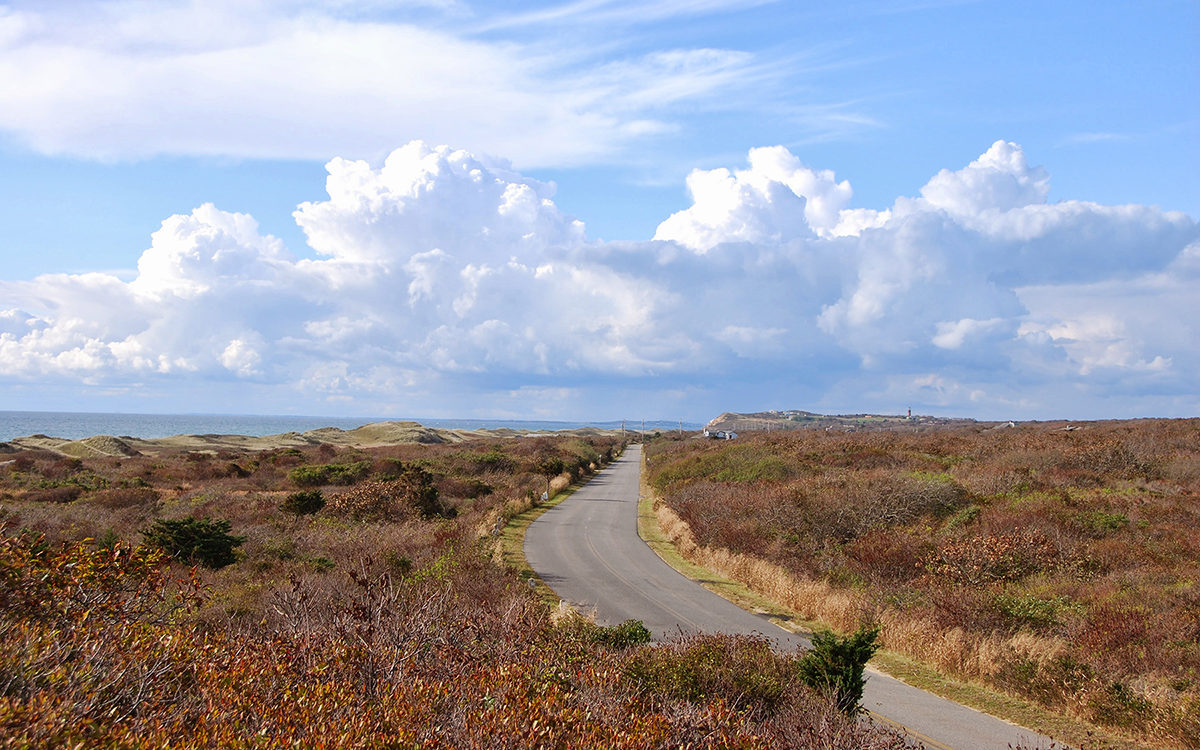
Moshup Trail Project
Wind-Blasted & Wild: A Special Place
At the terminus of its long journey, the Pleistocene glacial advance halted some 10,000 years ago on this Island. Today that formative geological event still defines the unique topography and ecology of Martha’s Vineyard. The glacier deposited alluvial plains to the east, rocky moraine to the west, and, in an extraordinary event, twisted and shoved upward ancient strata laid down in a primordial sea. This exposed for the first time 60 million-year-old cretaceous clays and 100 million-year-old lignite coal deposits: the iconic clay cliffs of Aquinnah.
Beyond the cliffs stretches the expanse of Moshup Trail, a wind-blasted, salt-spray-stunted, drought-prone place. Traveling along the Trail, one experiences the wildness of this largely unspoiled landscape. Its open moors are recognized as an exceptionally rare type of habitat called the Northeast Coastal Heathlands, home to species adapted to, and molded by, the prevailing harsh conditions. They include the spotted turtle, Nantucket shadbush, dragon’s mouth orchid, the northern harrier hawk, and a diversity of invertebrate species. Ecologists call Moshup Trail the most significant unprotected, undeveloped habitat in the New England region.
Read more about Moshup’s unique ecosystems: Diversity Matters
But life there is tenuous. The natural conditions are unforgiving, and additional stressors from development are not tolerated well. The most pressing threat to the heathlands is habitat fragmentation in the form of road building, house construction, and other impacts associated with human habitation, such as lights, noise, and pets. The result is that more than 90 percent of coastal heathlands habitat in the Northeast has been lost.
Because of Moshup Trail’s relative isolation, protection of its precious natural ecology and spectacular scenic resources is still possible. The people of Aquinnah, together with Island conservationists, have been working for decades to seize that opportunity – to save what’s left of the coastal heathlands.
Read more about the unique geologic history of the cliffs
The Moshup Trail Project
During the 1970s, the Town worked with the Vineyard Conservation Society and the Commonwealth of Massachusetts to adopt coastal wetland regulations. In 1980, a strategic property near the cliffs was purchased, with more than half the money coming from town residents. Soon after, the town successfully designated 186 acres along Moshup Trail as a special zoning overlay district, a District of Critical Planning Concern (DCPC) under the authority of the MV Commission. This DCPC was later expanded to include the entire town.
Throughout the 1990s, VCS worked piece-by-piece to facilitate conservation of nearly 40 acres of the heathland habitat. The Moshup Sanctuary was assembled through donations of land, purchases of critical parcels, and by recording voluntary conservation restrictions on private holdings.
Since then, the emphasis has shifted to legal defense of these conservation gains. Would-be developers of landlocked lots adjacent to the conserved lands sought to force subdivision access through the conservation lands. VCS and others responded, and we continue our vigorous defense of this special place. Two decades of litigation involving a series of cases in state and federal courts, including the Massachusetts Land Court and Supreme Judicial Court (plus a brief visit to the U.S. Supreme Court), has, more often than not, come out in favor of conservation, strengthening the land’s legal protection.
The seeds of this legal dispute were planted over a century ago. In 1862, the Massachusetts General Court passed an Act Establishing Gay Head as a District, changing the way the state related to the Wampanoags’ ancient communal system of land tenure. Ownership of enclosed lands was recognized, lands held in common were divided, and hundreds of small lots were created and deeded to local Wampanoag people. Since then, many of these so-called “set-off” lots have been conveyed out of tribal hands. Nearly one hundred and fifty years later, some of the lots have been conserved (by the Tribe, the Town, VCS, and other conservation entities), but many others located in the heart of the Moshup heathlands remain vulnerable to development.
Read more about the legal defense work of VCS
We are optimistic that recent indications of closure on the legal defense front mean the need for active litigation is behind us for now. More recently, our legal work has turned toward perfecting title to Moshup parcels gifted to VCS in 2013 by Red Gate Farm LLC. Much appreciation is due to the donors; their generosity will, once the legal work is done, add significantly to the protected habitat at the Moshup Sanctuary.
Funding for the Moshup Trail Project has been made available through the generosity of many private donors, including the Cedar Tree Neck Foundation, the Scheuer family, the Edey Foundation, the Helm Foundation, the Abraham and Ruth Krieger Foundation, and the Sweet Water Trust, as well as the Commonwealth of Massachusetts Executive Office of Environmental Affairs.
